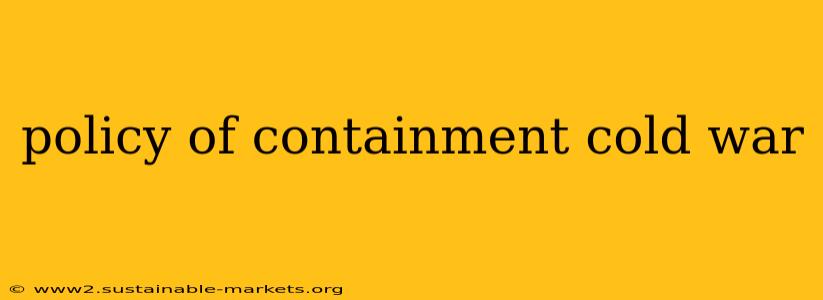The Cold War, a period of geopolitical tension between the United States and the Soviet Union and their respective allies, was characterized by a complex interplay of military buildup, ideological clashes, and proxy conflicts. At the heart of the American strategy throughout this era was the policy of containment, a doctrine that aimed to prevent the spread of communism. This wasn't merely a military strategy; it encompassed economic, political, and diplomatic efforts to counter Soviet influence globally.
Understanding Containment: More Than Just Military Might
Containment wasn't about directly attacking the Soviet Union. Instead, it focused on limiting the expansion of Soviet power and influence. This involved a multi-pronged approach:
1. Military Deterrence: The Nuclear Arms Race
A significant aspect of containment was the development and deployment of nuclear weapons. The threat of mutually assured destruction (MAD) served as a deterrent, preventing direct military conflict between the superpowers. However, this also fueled a dangerous arms race, leading to a constant escalation of military capabilities on both sides. The development of sophisticated weaponry, including ICBMs and advanced surveillance technologies, became central to maintaining a balance of power and deterring aggression.
2. Economic Aid and Support: The Marshall Plan and Beyond
Recognizing the vulnerability of post-war Europe to communist influence, the US implemented the Marshall Plan, a massive economic aid package designed to rebuild war-torn nations. By providing financial assistance and fostering economic growth, the US aimed to strengthen these countries' resistance to communist ideology and Soviet influence. This economic strategy extended beyond Europe, with various aid programs implemented globally to counter communist advances.
3. Political and Diplomatic Interventions: Supporting Allies and Resisting Soviet Expansion
Containment involved actively supporting anti-communist regimes and movements worldwide. This often meant providing financial, military, or political assistance to governments resisting Soviet pressure. The US engaged in diplomatic efforts to contain Soviet influence through international organizations like the United Nations, working to build alliances and secure international support for its policies. This led to numerous proxy conflicts, where the US and USSR supported opposing sides in regional conflicts, often fueling instability and violence.
4. Espionage and Propaganda: The Shadow War
The Cold War also included a significant "shadow war" involving extensive espionage and propaganda campaigns. Both sides sought to gather intelligence on each other's capabilities and intentions, while simultaneously engaging in efforts to shape public opinion both domestically and internationally. The CIA and KGB played crucial roles in these clandestine operations, employing various tactics to influence events and undermine their adversaries.
The Successes and Failures of Containment
While containment successfully prevented the direct military confrontation between the US and the USSR, its effectiveness is a subject of ongoing debate among historians.
Successes: Containment arguably prevented the further spread of communism in Western Europe and elsewhere. The Marshall Plan helped rebuild Europe, creating a strong economic foundation resistant to communist appeals. The formation of NATO provided a collective security framework that deterred Soviet aggression against its member states.
Failures: The policy’s emphasis on military strength led to a costly arms race, creating global instability. Intervention in various proxy wars often resulted in prolonged conflicts and human suffering. Furthermore, containment’s focus on anti-communist regimes sometimes overlooked human rights concerns and supported authoritarian governments that ultimately contributed to further instability.
The Legacy of Containment
The policy of containment significantly shaped the course of the 20th century, profoundly influencing global politics, economics, and military strategies. Its legacy continues to be debated, with discussions focusing on its successes, failures, and long-term consequences. Understanding containment requires a nuanced analysis of its various dimensions and its lasting impact on the global political landscape. While it prevented a direct military clash between superpowers, it also fostered a climate of fear and mistrust, leaving an enduring mark on the modern world.

